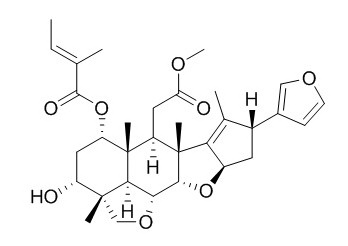Deacetylsalannin
Deacetylsalannin shows antifeedant activity against Reticulitermes speratus Kolbe (95% protective concentration or PC95 = 1373.1 ug/disc).
Inquire / Order:
manager@chemfaces.com
Technical Inquiries:
service@chemfaces.com
Tel:
+86-27-84237783
Fax:
+86-27-84254680
Address:
1 Building, No. 83, CheCheng Rd., Wuhan Economic and Technological Development Zone, Wuhan, Hubei 430056, PRC
Providing storage is as stated on the product vial and the vial is kept tightly sealed, the product can be stored for up to
24 months(2-8C).
Wherever possible, you should prepare and use solutions on the same day. However, if you need to make up stock solutions in advance, we recommend that you store the solution as aliquots in tightly sealed vials at -20C. Generally, these will be useable for up to two weeks. Before use, and prior to opening the vial we recommend that you allow your product to equilibrate to room temperature for at least 1 hour.
Need more advice on solubility, usage and handling? Please email to: service@chemfaces.com
The packaging of the product may have turned upside down during transportation, resulting in the natural compounds adhering to the neck or cap of the vial. take the vial out of its packaging and gently shake to let the compounds fall to the bottom of the vial. for liquid products, centrifuge at 200-500 RPM to gather the liquid at the bottom of the vial. try to avoid loss or contamination during handling.
Front Plant Sci.2022, 13:982771.
LWT2021, 138:110397.
Molecules.2023, 28(8):3291.
Int J Mol Sci.2023, 24(14):11496.
Neuropharmacology.2018, 131:68-82
Food Funct.2022, D1FO03838A.
Korean Journal of Medicinal Crop Science2018, 26(5):382-390
Am J Chin Med.2023, 51(4):1019-1039.
Front Immunol.2017, 8:1542
Agriculture2024, 14(12), 2301
Related and Featured Products
J Agric Food Chem. 2009 Mar 25;57(6):2457-61.
Persistence of two neem formulations on peach leaves and fruit: effect of the distribution.[Pubmed:
19292469]
Persistence of azadirachtins (A+B) and of the other limonoids (nimbin, salannin, deacetylnimbin, and Deacetylsalannin) on peach leaves and fruits was studied using a commercial formulation (form. C) compared with an experimental formulation (form. E) prepared with coformulations allowed in organic culture.
METHODS AND RESULTS:
Field experiments were carried out using three concentrations: 1x, 5x, and 10x the dose recommended by the manufacturer. The EU maximum residue level (MRL) in fruits and vegetables for azadirachtin A is 1 mg/kg with a preharvest interval (PHI) of 3 days. At the recommended dose, azadirachtin A residue on fruits was not detectable (LOQ < 0.8 microg/kg). After field treatment at the 5x concentration, azadirachtoids were found with 22% in the epicuticular waxes and the remaining 78% on the fruit surface. No residues were found in the fruit pulp. The experimental formulation (E) produced lower residues on leaves and fruit compared with the commercial formulation (C), although formulation E showed greater stability.
CONCLUSIONS:
This is probably due to the amount of the active ingredients that diffuse into the epicuticular wax layer thus enhancing photostability of azadirachtoids.
J Agric Food Chem. 2006 Dec 27;54(26):10026-32.
Residues and persistence of neem formulations on strawberry after field treatment.[Pubmed:
17177537]
METHODS AND RESULTS:
Azadirachtoids were determined by liquid chromatography/mass spectrometry (LC/MS) in five methanolic seed extracts of the neem tree and in a commercial formulation. On average, seed extracts contain azadirachtin A (10.9%), azadirachtin B (3.5%), nimbin (10.4%), and large quantities of salannin (19.0%). The composition of the commercial formulations may present different azadirachtoids contents depending on the natural extracts used in the preparation. Because these compounds may also show insecticide activity, the efficacy on field of these formulations may be very different. Photodegradation of pure azadirachtoids was also studied. Azadirachtins and related compounds are very sensitive to sunlight, degrading rapidly, with half-lives of the order of 11.3 h for azadirachtin A and 5.5 h for azadirachtin B and few minutes for the other limonoids compounds studied. The residues of azadirachtins and the main constituents, e.g., salannin, nimbin, deacetylnimbin, and Deacetylsalannin, of the neem seed extract were determined on strawberries after field treatment using two different formulations. This residue study on strawberry was carried out to assess not only the azadirachtin content but also the main azadirachtoids contents.
CONCLUSIONS:
Three days after field application at five times the dose recommended by the manufacturer, residues of azadirachtin A and B were 0.03 and 0.01 mg/kg, respectively, while residues of salannin (LOQ 0.01 mg/kg) and nimbin (LOQ 0.5 mg/kg) were not detectable.
Bioscience Biotechnology & Biochemistry, 1992 , 56 (11) :1835-1838.
Several Antifeedants from Neem Oil, Azadirachta indica A. Juss., against Reticulitermes speratus Kolbe (Isoptera: Rhinotermitidae)[Reference:
WebLink]
METHODS AND RESULTS:
A methanol extract of neem oil indicated antifeedant activity at 200 μg/disc by a no-choice bioassay against Reticulitermes speratus Kolbe. The extract was purified by recycling HPLC to isolate 11 compounds of variable termite antifeedant potency. Deacetylgedunin was the most active compound (95% protective concentration or PC95 = 113.7 μg/disc). This was followed by salannin, gedunin, 17-hydroxyazadiradione, nimbandiol, azadiradione, Deacetylsalannin, and deacetylnimbin, with PC95 estimates of 203.3, 218.4, 235.6, 245.4, 827.5, 1373.1, and 1581.2 μg/disc, respectively. Epoxyazadiradione, 17-epiazadiradione, and nimbin were not active (PC95 estimates were beyond the bioassay limits).
CONCLUSIONS:
It could be presumed, by comparing their structures and activities, that the furan ring, αβ-unsaturated ketone and hydroxyl group each played an important role in determining the antifeedant activity.



